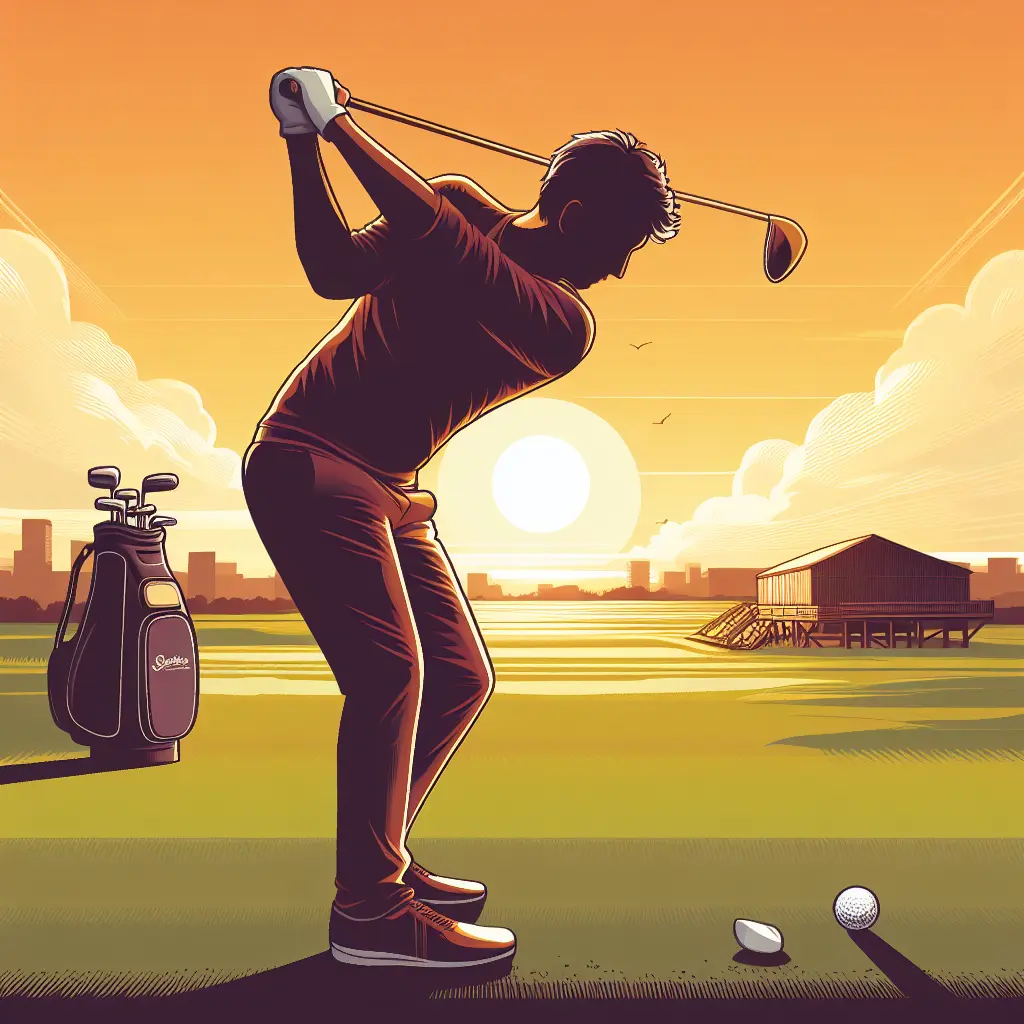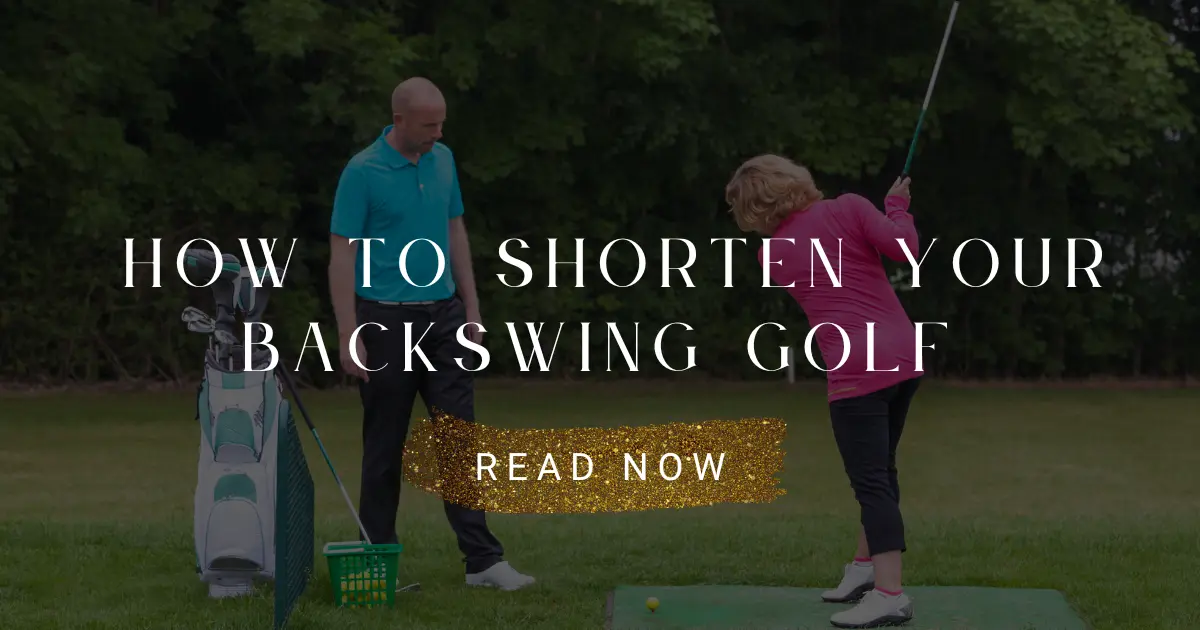Shortening your backswing in golf can be a beneficial adjustment to make to improve your overall game. If your backswing is currently full and goes parallel to the ground, you may want to shorten it in order to improve control and consistency. One way to achieve a shorter backswing is by focusing on your takeaway. During the initial phase of your golf swing, pay attention to keeping your hands and club in a more controlled position as you bring the club back.
This will help prevent over-rotation and the tendency to swing the club too far back. Additionally, practicing with a shorter backswing will help you maintain better balance and stability throughout the swing, leading to more accurate shots. It is important to ensure that shortening your backswing does not negatively impact your power and distance.



By focusing on the quality of your swing and maximizing the leverage in your body and club, you can still achieve impressive distance even with a shorter backswing. With determination and practice, shortening your backswing in golf can lead to improved accuracy and control in your game.
What Is a Backswing?
In golf, the backswing is the motion of taking the club back away from the ball. It’s the first part of the full golf swing. From the address position, the club is brought back and up, before transitioning into the downward swing.
The length of the backswing varies by player, but generally ranges from parallel to the ground to slightly past parallel at the top. Longer backswings tend to create more power, while shorter swings focus on control. There is no universally “correct” length, as pros have succeeded with a wide range of backswing lengths.
The Best Drills to Shorten Your Backswing
In the realm of golf, having a long backswing can be detrimental to your game, as it can result in inconsistencies and loss of power. Thus, finding a way to shorten your golf backswing is crucial for improving your overall performance on the golf course. One of the best drills to achieve a shorter backswing is to focus on taking the club back short of parallel. This means that when you bring the club back, it should stop short of reaching a parallel position with the ground.
By doing so, you will effectively limit the amount of movement in your backswing, resulting in a more controlled and compact swing. Another effective drill to shorten your backswing is to concentrate on the wrist hinge. It is important to ensure that you are not over-hinging your wrists, as this can lead to an overly long backswing. Instead, focus on maintaining a slight wrist hinge as you take the club back.
By incorporating these drills into your practice routine, you will be well on your way to achieving a more consistent and powerful golf swing. If you want to shorten your backswing and improve your overall game, these drills are essential to incorporate into your training regimen.
Why Shorten Your Backswing?
Shortening your backswing can be a beneficial adjustment for improving your golf game. By shortening the length of your backswing, you can maintain better control over the club and use your lower body to generate more power when hitting the ball. In order to shorten your swing, focus on reducing the amount of movement in your arms and wrists during the backswing.
This will allow for a more efficient way to connect with the ball and achieve better contact. Shortening the backswing can also help increase your swing speed, ultimately leading to improved distance and accuracy. Therefore, considering shortening my swing could be a worthwhile adjustment to enhance my overall performance on the course.
There are several potential benefits to using a more compact backswing:
More Consistency
A shorter backswing has less room for variance. With a shorter arc, there are fewer places for flaws to creep in. It’s simply easier to reproduce the same backswing over and over. Consistency leads to lower scores.
Better Balance
Taking the club back a shorter distance helps maintain posture and balance. With a shorter swing, it’s less likely to sway or lurch backward, which causes inconsistency. Better balance equals more solid contact.
More Control
Limiting the backswing naturally promotes a more controlled, measured swing. With fewer moving parts, the swing stays “in sync” and on plane. Accuracy comes from control over the club.
Faster Transition
A shorter backswing allows an easier transition into the downswing. Less time assembling into the backswing equals more time unleashing into the downswing. This generates clubhead speed.
Less Complexity
Trying to coordinate a long, technically perfect backswing is challenging. Eliminating some of the backswing’s complexity allows focus on the rest of the motion. Simplifying any part of the swing helps consistency.
Power From Compression
A shorter backswing loaded close to the body allows compressing the ball at impact. This compression transfers energy more efficiently and can increase distance without an overly long swing.
Why Will You Want a Short Backswing in Golf?
A shorter backswing in golf can be advantageous for a variety of reasons. One significant benefit of a shorter backswing is the ability to maintain lag in your swing, which can lead to more power and control in your shots. Additionally, a shorter backswing can help prevent a swing change that may lead to the need to hit a pull or lose control of the clubhead. By keeping the backswing compact, golfers are also able to better focus on compressing the golf ball at impact, resulting in more solid and consistent contact with the ball.
In contrast, a longer backswing can lead to a looser swing at the top, making it more difficult to generate power and control. Utilizing a shorter backswing allows golfers to take a practice swing that stays within a comfortable and controlled range, leading to more consistent and accurate ball striking. Overall, a shorter backswing can help golfers maintain control and power in their shots, as well as promote solid contact with the golf ball.
FAQs
How do I shorten my golf backswing?
There are a few effective ways to shorten your golf backswing:
- Grip down an inch or two on the club to reduce leverage and restrict the arc.
- Slow down your backswing tempo and eliminate any abrupt motions.
- Limit wrist hinge and cocking until later in the backswing.
- Focus on turning your shoulders and hips together while keeping your upper body still.
- Check your grip, stance width, ball position and posture and make adjustments as needed.
- Practice with a towel or short club to get the feel of a compact backswing.
- Make progressive changes over time, don’t go cold turkey all at once.
How do you fix a long backswing?
Gripping down, slowing tempo, minimizing wrist hinge, turning shoulders together, and making setup adjustments will help fix an overlong backswing. Use towel and short club drills to guide your backswing to the proper length. Make changes gradually over multiple range sessions.
How short should my backswing be?
The ideal backswing length is about three-quarters of a full circle or just short of parallel. Going much past parallel can make it hard to control the clubface and return to impact. For most golfers, the hands should reach no farther back than between the shoulders.
How does the short golf backswing affect spinal health implications?
A shorter, more compact golf backswing correlates with a reduced risk of spinal issues compared to an overly long backswing. Less extension and lateral bending on the backswing minimizes stress and torque on the lumbar and thoracic spine. It also promotes better posture and core activation throughout the motion.
Be Patient!
Shortening your overswing will feel very unnatural at first, and your timing will likely be off. Stick with it and be patient through the adjustment phase. As you groove the new motion and sequence, your ball striking and consistency will improve.
Allow yourself time to make mistakes and work through the changes. With sufficient practice, your new shortened backswing will begin to feel comfortable and normal. Don’t lose faith swinging through the awkward stages.
Shortening an overswing is one of the most reliable ways to improve ball striking and become more consistent. Follow these tips to assess your backswing, make adjustments, and groove a more compact motion. With some patience and practice, you’ll be hitting it solidly on plane in no time!


